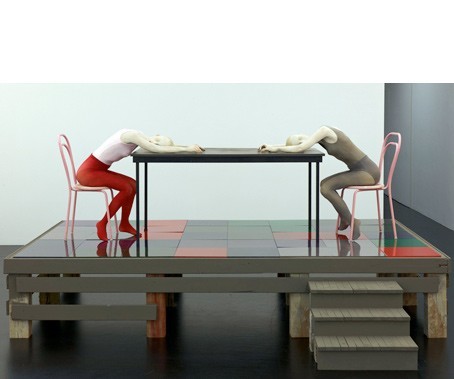Pascale and Arienne Birchler
21 Jan - 03 Mar 2012
PASCALE AND ARIENNE BIRCHLER
21 January - 3 March, 2011
Between the two Swiss born twin sisters, Pascale and Arienne Birchler, there has occurred, since childhood, a continuous exchange of experiences, adventures and thoughts. A tight bond, often associated with twins, is a strong component of both of their works and has developed to become the most important influence throughout their years of practice. It is the view of the other that helps each to approach their personal aims; by an intense dialogue they each accompany the other for a while then together let things slowly grow.
Galerie Nicola von Senger is pleased to present this symbiosis; Pascale, who exhibited works during a group show with us in 2010, and Arienne, a fashion designer in Antwerp and New York, are here presenting their works together for the first time. Starting from beautifully detailed, small format drawings and sketch book collages the two artists have searched for and developed a sense of instantaneousness that finds expression in the work’s delicate accuracy. In the fleetingness of their design the sisters’ installations remind one of film-stills; as important the shown moment seems to be it can just as quickly change or disappear. In one example, two girls appear in a moment of pausing, exhausted and at the same time full of energy. They are resting their heads on a table, spellbound, tiredly dreaming and childlike-thrilled. In that brief moment the artists appear to skilfully capture the subjects’ innate curiosity of and desire for the future, their presentiment that their search for identity is beginning and perhaps their childlike bond will be displaced, a fear mixed with an excitement and a sense of melancholy. This, when glimpsed by the viewer, initiates an almost protective reaction towards the figures. Absorbed in their thoughts the two are listening hopefully for answers.
Pascale and Arienne provide us with sensuous orchestrations and delicate stages that broach the issue of the vulnerability of humans. They play with suggestions that never become obvious. Tender intrusions deviate from the regular and move into the area of surrealism. What we see, however, is never a dream but rather the sisters’ own reality, which carries biographical streaks, visualises hidden moments and appears either familiar or strange to the viewer. Judith Platte / Gareth Malone, December 2011
21 January - 3 March, 2011
Between the two Swiss born twin sisters, Pascale and Arienne Birchler, there has occurred, since childhood, a continuous exchange of experiences, adventures and thoughts. A tight bond, often associated with twins, is a strong component of both of their works and has developed to become the most important influence throughout their years of practice. It is the view of the other that helps each to approach their personal aims; by an intense dialogue they each accompany the other for a while then together let things slowly grow.
Galerie Nicola von Senger is pleased to present this symbiosis; Pascale, who exhibited works during a group show with us in 2010, and Arienne, a fashion designer in Antwerp and New York, are here presenting their works together for the first time. Starting from beautifully detailed, small format drawings and sketch book collages the two artists have searched for and developed a sense of instantaneousness that finds expression in the work’s delicate accuracy. In the fleetingness of their design the sisters’ installations remind one of film-stills; as important the shown moment seems to be it can just as quickly change or disappear. In one example, two girls appear in a moment of pausing, exhausted and at the same time full of energy. They are resting their heads on a table, spellbound, tiredly dreaming and childlike-thrilled. In that brief moment the artists appear to skilfully capture the subjects’ innate curiosity of and desire for the future, their presentiment that their search for identity is beginning and perhaps their childlike bond will be displaced, a fear mixed with an excitement and a sense of melancholy. This, when glimpsed by the viewer, initiates an almost protective reaction towards the figures. Absorbed in their thoughts the two are listening hopefully for answers.
Pascale and Arienne provide us with sensuous orchestrations and delicate stages that broach the issue of the vulnerability of humans. They play with suggestions that never become obvious. Tender intrusions deviate from the regular and move into the area of surrealism. What we see, however, is never a dream but rather the sisters’ own reality, which carries biographical streaks, visualises hidden moments and appears either familiar or strange to the viewer. Judith Platte / Gareth Malone, December 2011

